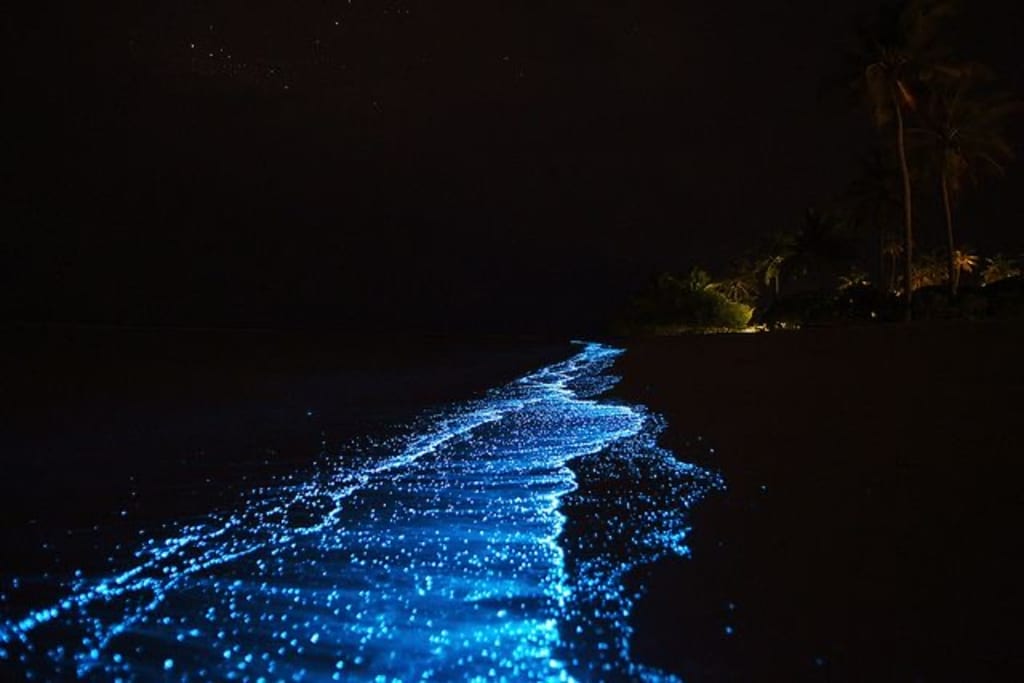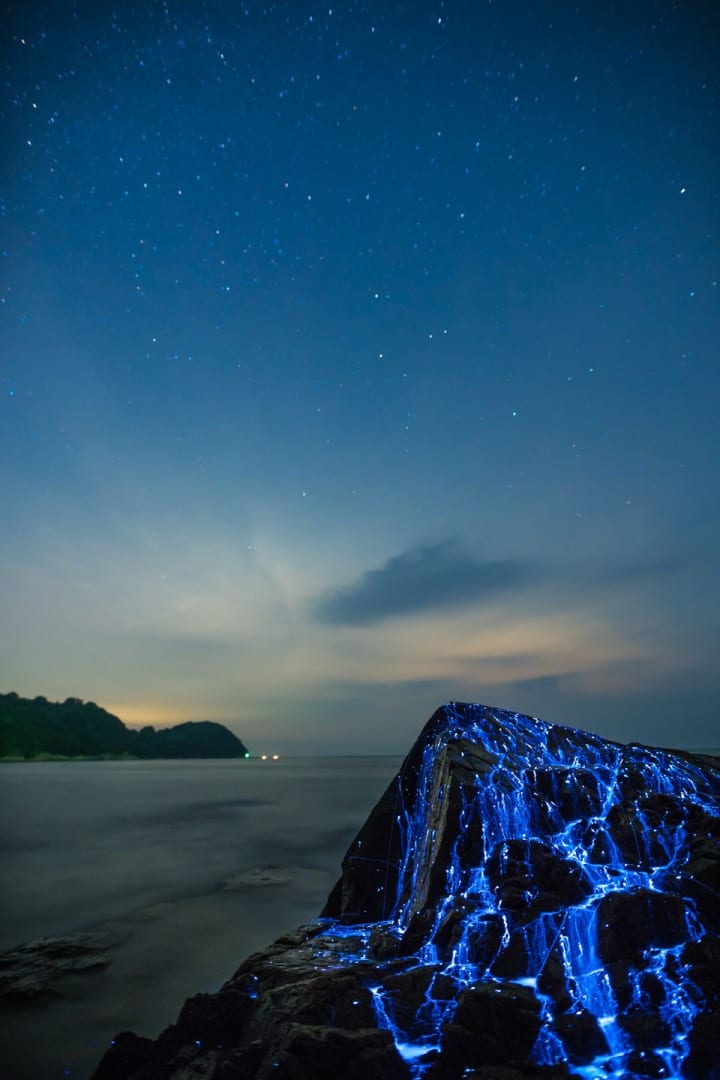Plankton beauty benefit. Bioluminescent phenomenon magic waters.
These illuminated waters aren’t a magic trick – they’re the natural phenomenon of bioluminescent plankton.

Forget the neons of Tokyo. For an otherworldly light experience visit the bioluminescent ‘sea fireflies’ on the beaches of the Inland Sea.
A rock thrown into the Derwent River in Tasmania, emits a blue light from a disturbed microalgae.
Microalgae called Noctiluca scintillans, common name sea sparkle, give off light when disturbed, for example, when a rock is tossed into the water.
Walk Along Bioluminescent Bay in San Diego, California.
The amazing story at Oregon Coast Beach Connection.
The beautiful phytoplankton creates an iridescent glow as she moves through mounds of phytoplankton called dinoflagellates. Their freaky glow is similar to the way fireflies glow. Unlike fireflies though, dinoflagellates are microscopic.
Travellers to exotic waters, like those surrounding the islands of the Maldives, may be treated to a natural phenomenon that turns the night-time ocean into a field of glowing stars.
One of the most popular places to observe such a fantastic spectacle is Vaadloo island found in the Raa Atoll, and the high season is between June and October.
One of the most spectacular sights on a night dive in the ocean is to witness the hundreds of tiny star-like bioluminescent phytoplankton scintillating like a starry sky as you move through the dark water. Towards the end of a dive, just shield your underwater flashlight and wave your hands through the water in front of you, and be mesmerized by the tiny glowing specs of plankton.

The glowing is caused by simple chemistry: Some species have natural chemical reactions in their bodies that causes light to be emitted. Ever see a firefly on a summer evening? It’s the same process.
There are several aquatic species that display bioluminescence, including varieties of fish, jellyfish and crustaceans. But the most common are tiny single-cell organisms called dinoflagellates. They’re the ones that give off the distinctive bluish-green glow when something disturbs the water.
Photographer and scientist
Dr Richard Kirby has dedicated his career to studying and photographing plankton, which live in huge numbers in the ocean.
His book, 'Ocean Drifters: A Secret World Beneath the Waves', puts plankton under the microscope, so people can appreciate their varied and usual features, from the bulbous eyes and hairy legs of larger zooplankton to the strange geometric shapes of smaller phytoplankton, which can be a type of algae.
The organisms include drifting animals, microorganisms, algae and bacteria that live in the sea, or fresh water.
The microscopic algae and the tiny animals that eat them float freely in the sunlit surface of the sea, where they underpin the marine food chain, provide the world with oxygen and play an essential role in the global carbon cycle.
Scientists are also studying how bioluminescence might prove useful for humans.
For example, one application could be using the same chemical reaction to replace outdoor and interior electrical lighting. One company is already using luminescent bacteria to test water quality. Bioluminescence is also being used to track human cells, which could lead to better treatments for cancer or other serious diseases.
Plankton beauty benefit
Plankton are microscopic organisms that float in water in great numbers. They absorb carbon dioxide and sunlight to produce the energy they need for growth and metabolism. Depending on their natural habitat, plankton have different properties and benefits for the organism. There is, for example, one species of plankton that has developed an enzyme that can repair the cell damage caused by sunlight. Similar to this defense mechanism against UV radiation, some kinds of plankton have also found a way to protect themselves against blue light (high energy visible light naturally occurring in sunlight). Their cells are encased in a delicate glass shield that looks like a glass diamond and is able to repel harmful radiation, while still being able to absorb the light needed for photosynthesis.
History
The marine biologist Johannes Peter Müller is widely considered the founding father of plankton research. He began researching these organisms in 1846 on the island of Helgoland.
Effect
Plankton is an incredibly versatile skincare ingredient! It protects the skin from UV radiation and blue light and helps to prevent pollutants and toxins from penetrating the skin. It reduces oxidative stress, protects the cells and fights the signs of premature skin aging. Furthermore, plankton has antibacterial properties and can strengthen the skin barrier. In addition to its protective properties, it helps to firm and mattify the skin and provide a soft focus effect for an even-toned complexion.
Plankton extract
A marine species known as Thalasso plankton and derived from various algae, seaweed, or marine skeletons. There is no research showing plankton extract has any benefit for skin but, like most forms of algae, it can have moisture-binding properties. Although that's good, keep in mind plankton isn't a miracle (not even a minor one) or a must-have ingredient for skin.
Plankton Extract is an extract of marine biomass which includes one or more of the following organisms: Thalasso plankton, green micro - algae, diatoms, greenish-blue and nitrogen-fixing seaweed. Used in skin care products for its effective moisturizing and antoxidant benefits.
Extraction: this active is obtained from the unicellular microalga, Tisochrysis lutea.
Benefits: this ingredient activates and stimulates the natural fat burning mechanisms and can effectively reduce the appearance of cellulite in only 2 months. Additionally, studies have indicated that plankton significantly increases skin’s elasticity and firmness. It works by strengthening cell cohesion and renewing the skin’s protective barrier.
The best products with the into the plankton are Biotherm, The Ordinary and Beauty kitchens.
About the Creator
Fluo & Pattern
Makeup artist, fashion/beauty blogger.
Journalist, editor and writer, and body painter of events and TV show.






Comments
There are no comments for this story
Be the first to respond and start the conversation.